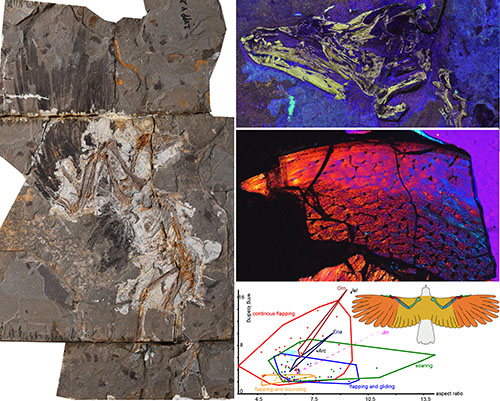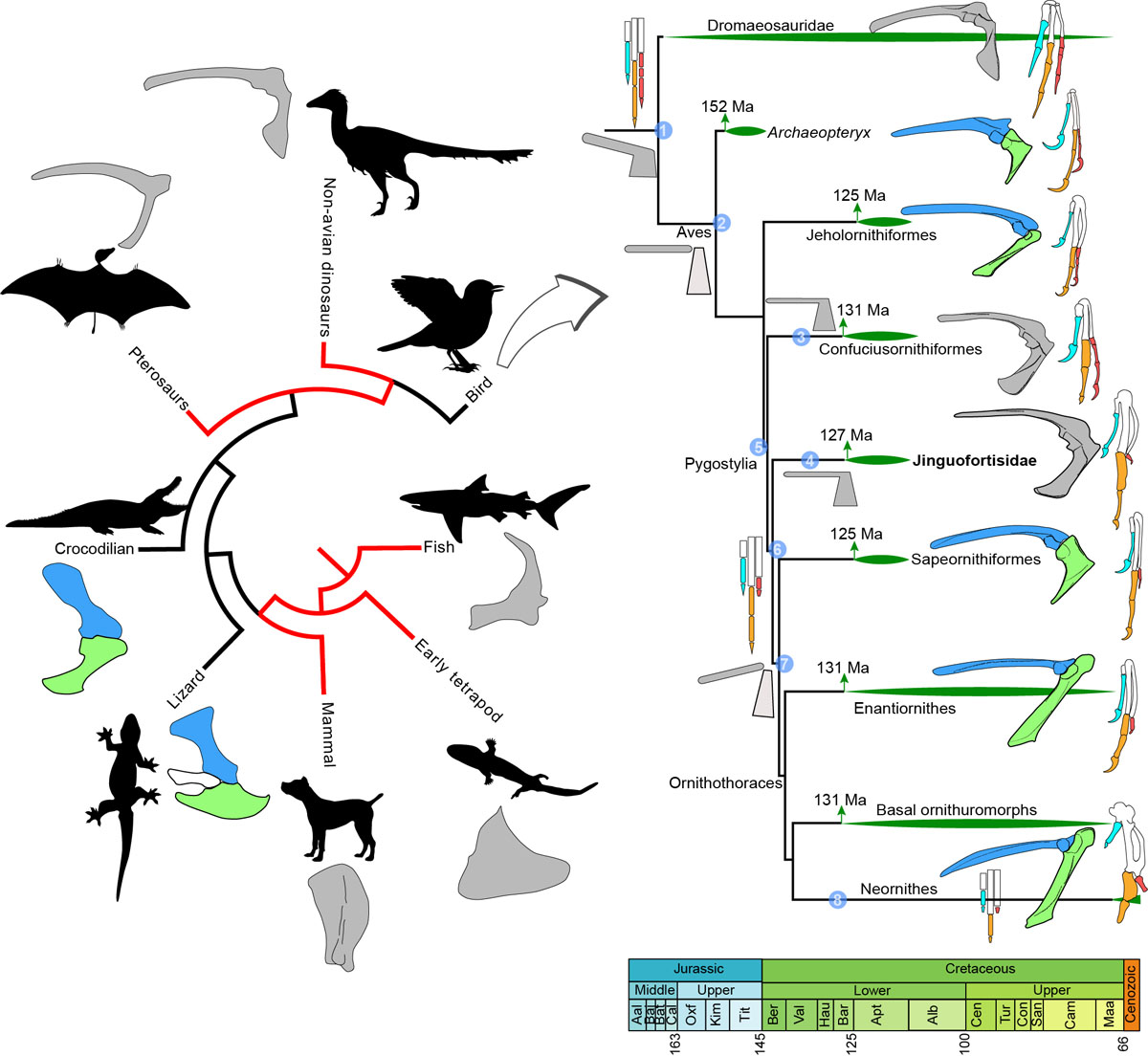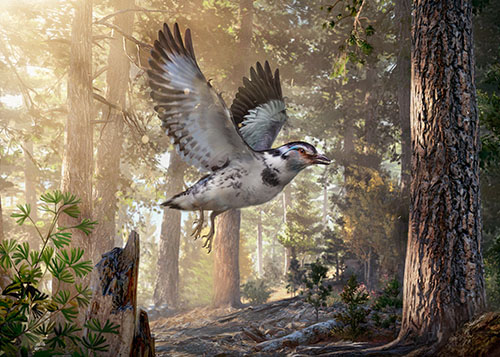Recently, Wang Min, Zhou Zhonghe, and Thomas from the Institute of Vertebrate Paleontology and Paleoanthropology of the Chinese Academy of Sciences published the latest research results in the Proceedings of the National Academy of Sciences (PNAS), reporting on an early Cretaceous primitive bird discovered in China: The Confused Woman Bird (Jinguofortis perplexus). The discovery of the female bird provides a lot of key information for discussing the early evolution and ecological differentiation of birds, indicating that developmental plasticity plays a very important role in the early evolution of birds.
The female bird was discovered in the Dabeigou Formation of the Early Cretaceous in Hebei Province. In 2017, a research team led by Zhou Zhonghe conducted a field investigation at the site and sampled the overlying volcanic ash. Researcher Meng Qingren of the Institute of Geology and Geophysics, Chinese Academy of Sciences, used the SIMS zircon U-Pb dating method to determine that the female bird lived about 127 million years ago. The research team conducted comparative morphology, bone histology, flight ability and phylogeny research on the female bird, and concluded that the female bird is the most primitive pygostellate bird known after the order Confuciusornis. Pyrrhoids refer to birds in which several tail vertebrae at the end are fused into a composite bone (called a pygoid), covering all birds except Archaeopteryx and Jeholavian. Enantiornithes and anthoornithids (the latter evolved all modern birds) are the most successfully evolved birds in the Mesozoic Era. The early molecules of these two groups have shown a large number of progressive morphological and physiological characteristics, and there are many genera and species. The species of the pygophylloids, which are more primitive than enantiornithids and modern ornithomorphs, are very rare, with only Confucius birds and Trichopteryx birds. This creates an "evolutionary gap" between the most primitive long-tailed birds (Archaeopteryx, Jeholavian) and the more advanced enantiornithids and modern birds, which greatly limits our understanding of the evolution of urospermids. Initial understanding. The female bird just fills this gap, it shows a highly mosaic of evolutionary features: the dentition, part of the skull and shoulder girdle morphology are similar to those of non-avian theropod dinosaurs, but it also has vestigial fingers, elongated forelimbs, and healing Typical bird characteristics such as the coccygeal bone, which is the source of its species name. Its genus name is taken from the Chinese pinyin of "女帼" and is dedicated to all female researchers working on the front line.
The female bird is similar in shape to the Chongmingia bird reported in a 2016 study. Chongmingornis is not completely preserved, especially missing its tail vertebrae and skull, so its systematic location was difficult to determine in its initial studies. The discovery of the female bird provides clues to solve the taxonomic position of the Chongmingbird: research on the phylogeny of a large number of Mesozoic birds shows that the female bird and the Chongmingbird form a sister group, and belong to the most primitive tailed birds known except Confucius. Based on the osteophytes, the research team named this branch Jinguofortisidae. The most obvious feature of the Cyprinididae is the healed coracoid and scapula (called the scapular coracoid). This phenomenon is only seen in Mesozoic birds in the order Confucius, and among living birds it is mainly seen in the Palaeognathids. (ostriches, emu, etc.), while in most birds with the ability to fly these two bones are independent of each other. The healed coracoid bone of the scapula is a very primitive feature. It even precedes the appearance of the digits (toes) in the evolutionary history of tetrapods; the separation of the two first began in primitive amniotes and was subsequently widely distributed. (such as squamates, crocodiles, etc.), but at the same time, some groups independently evolved healed scapula coracoids, including most non-avian dinosaurs and pterosaurs. The scapula and coracoid often show a tendency to heal each other during development, which is mainly due to the fact that they originate from undifferentiated homogeneous condensation in the early stages of development. During the process of chondrogenesis, when osteogenesis or the differentiation of preosteocytes is delayed, the separation of the two bones will occur.
By tracing the development of these two bones in the main groups of tetrapods, the research team proposed that the healing of the scapula coracoid occurred independently in the Confucius order and the Hematoridae, and the healing may have originated from these two The relatively rapid osteogenesis in the ontogeny of this taxon, and analysis of the bone tissue structure of primitive birds also support this hypothesis. Heroine and Confucius Birds grow faster than Archaeopteryx and Jehol Birds. The faster growth rate can shorten the time required to reach adulthood and reduce the chance of being preyed on. However, at the same time, the accelerated bone formation makes the scapula and coracoid bones During the ossification process, the "futures" separate from each other, thus forming a healed scapula coracoid (which can be seen as a "side effect" of accelerated ossification). However, the growth rate of birds, primitive birds and enantiornithes, which are more advanced than heroines, is slower. The early representatives of modern birds and enantiornithids were significantly smaller than female birds, so the slowed growth rate would not significantly extend the time required to reach adulthood; and these two groups already have skeletons similar to modern birds —Muscle system. During the embryonic development stage, different muscles act in different directions on the scapula and coracoid, which are still in the cartilage stage, which is conducive to the separation of the two bones from each other during the ossification process. The research team proposed that the coracoid bones of the scapulae in the Heroine and Confuciusornis may come from over-typing during heterochronic development (due to rapid growth, the descendants appear to have the characteristics of their ancestors in the early stages of development, and on this basis further growth to form new characteristics), reflecting developmental plasticity. Developmental plasticity refers to the ability of an organism to change its developmental process when the environment changes, and this process often induces the emergence of new characteristics. The above findings further indicate that developmental plasticity is a very critical factor when discussing the early evolution of birds or other organisms (especially mosaic evolution).
This research was supported by the National Natural Science Foundation of China Outstanding Youth Fund, the Basic Science Center Project, and the Youth Innovation Promotion Association of the Chinese Academy of Sciences.

Figure 1. The holotype specimen of the Doubtful Ladybird, skull LSF imaging, bone tissue structure, and wing load-aspect ratio distribution of primitive birds (photo provided by Wang Min)

Figure 2. A simplified diagram of the scapula-coracoid evolution of the main groups of vertebrates; the Mesozoic bird phylogenetic tree reveals the important evolutionary stages of shoulder girdle and hand bones (photo provided by Wang Min)

Figure 3. Restoration of the Doubtful Ladybird (drawn by Zhang Zongda)
animal tags: heroine birds archaeopteryx confuciusornis evolution
We created this article in conjunction with AI technology, then made sure it was fact-checked and edited by a Animals Top editor.